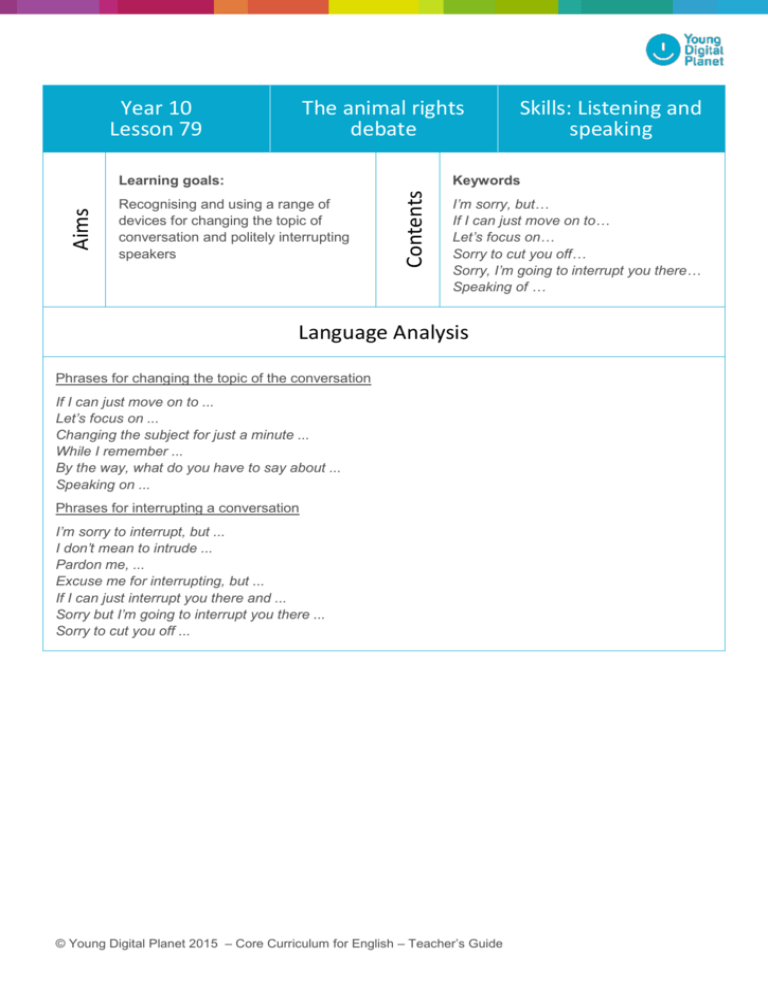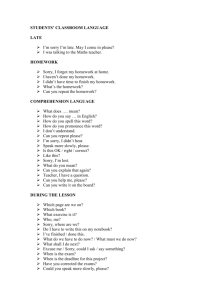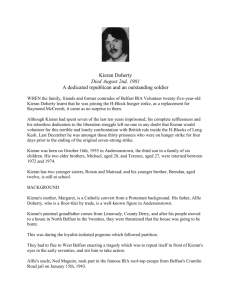Young Digital Planet 2015 – Core Curriculum for English
advertisement

Year 10 Lesson 79 The animal rights debate Keywords Recognising and using a range of devices for changing the topic of conversation and politely interrupting speakers Contents Aims Learning goals: Skills: Listening and speaking I’m sorry, but… If I can just move on to… Let’s focus on… Sorry to cut you off… Sorry, I’m going to interrupt you there… Speaking of … Language Analysis Phrases for changing the topic of the conversation If I can just move on to ... Let’s focus on ... Changing the subject for just a minute ... While I remember ... By the way, what do you have to say about ... Speaking on ... Phrases for interrupting a conversation I’m sorry to interrupt, but ... I don’t mean to intrude ... Pardon me, ... Excuse me for interrupting, but ... If I can just interrupt you there and ... Sorry but I’m going to interrupt you there ... Sorry to cut you off ... © Young Digital Planet 2015 – Core Curriculum for English – Teacher’s Guide Procedure Lead-in Key: Students’ own answers. Suggested answers: 1 A mouse is being used in a laboratory experiment. 2 Student’s own answers. 3 Three arguments for animal testing: it has yielded a number of effective drugs for humans, more animals are killed for food but not eaten than are used in animal testing, animal tests are used for more than just developing medicine – they also contribute to the advancement of surgical techniques and medical equipment. Three arguments against animal testing: it is wrong that animals should suffer or die for the benefit of humans, many animal experiments do not turn out to benefit people, animals and humans are different so test results are usually not reliable Ask students to look at the picture. Then put them in pairs and tell them to answer the questions. Extension: Choose some pairs to share their views. Then hold a full class discussion about whether animal testing is right or wrong. © Young Digital Planet 2015 – Core Curriculum for English – Teacher’s Guide Main input Audio: Presenter: Good afternoon, and welcome to the programme. Joining me today are Elaine Fisher, president of the World Animal Protection Trust, and Kieran Scott, who’s a spokesman for a medicines company. We’re going to be discussing the issue of testing medicines on animals. Elaine, let’s start with you. Elaine: Well, I think it’s clear that using animals to test medicine is completely wrong. We’re not just talking about mice and rats, these companies also use animals like pigs and monkeys in their experiments. It’s cruel, the animals suffer, and the results are often useless. Kieran: Sorry Elaine, I’m going to interrupt you there. First of all, no experiment is perfect but the results of tests on animals have led to some important medical breakthroughs. And we actually do around 97 percent of our research on small animals like rats and miElaine: I’m sorry Kieran, but let’s focus on the real issue, which is that these animals are made to suffer. It doesn’t matter if you harm a mouse or a pig, it’s still wrong. Kieran: We have exceptional standards of animal welfare, Elaine, and if I can just move on to some facts, I think you’ll find that household cats kill more small animals in a week than we use in tests over a whole year. We actually- Read and explain the information in the grammar box to the class. Then tell students to listen and put the sentences in the order that they hear them. Elaine: Sorry to cut you off Kieran, but we’re not talking about household cats, we’re talking about tests on animals, carried out by humans. Speaking of humans, why don’t you tell us the real reason for using animals in your experiments? It’s money, isn’t it? Kieran: I’m happy to debate the issues Elaine but we need to base the discussion on facts. First of all, ... Key: © Young Digital Planet 2015 – Core Curriculum for English – Teacher’s Guide Correct order: Sorry Elaine, I'm going to interrupt you there … I'm sorry Kieran, but … Let's focus on … If I can just move on to … Sorry to cut you off … Speaking of humans … © Young Digital Planet 2015 – Core Curriculum for English – Teacher’s Guide Practice 1 Audio: Presenter: Good afternoon, and welcome to the programme. Joining me today are Elaine Fisher, president of the World Animal Protection Trust, and Kieran Scott, who’s a spokesman for a medicines company. We’re going to be discussing the issue of testing medicines on animals. Elaine, let’s start with you. Elaine: Well, I think it’s clear that using animals to test medicine is completely wrong. We’re not just talking about mice and rats, these companies also use animals like pigs and monkeys in their experiments. It’s cruel, the animals suffer, and the results are often useless. Kieran: Sorry Elaine, I’m going to interrupt you there. First of all, no experiment is perfect but the results of tests on animals have led to some important medical breakthroughs. And we actually do around 97 percent of our research on small animals like rats and mi- Focus students’ attention on the red buzzer. Tell them to listen and press the buzzer when they hear one of the speakers change the topic. Elaine: I’m sorry Kieran, but let’s focus on the real issue, which is that these animals are made to suffer. It doesn’t matter if you harm a mouse or a pig, it’s still wrong. Kieran: We have exceptional standards of animal welfare, Elaine, and if I can just move on to some facts, I think you’ll find that household cats kill more small animals in a week than we use in tests over a whole year. We actuallyElaine: Sorry to cut you off Kieran, but we’re not talking about household cats, we’re talking about tests on animals, carried out by humans. Speaking of humans, why don’t you tell us the real reason for using animals in your experiments? It’s money, isn’t it? Kieran: I’m happy to debate the issues Elaine but we need to base the discussion on facts. First of all, ... Key: © Young Digital Planet 2015 – Core Curriculum for English – Teacher’s Guide The phrases where students should press the buzzer are highlighted in yellow below: Presenter: Good afternoon, ... Elaine: I’m sorry Kieran, but let’s focus on the real issue, which is that these animals are made to suffer. It doesn’t matter if you harm a mouse or a pig, it’s still wrong. Kieran: We have exceptional standards of animal welfare, Elaine, and if I can just move on to some facts, I think you’ll find that household cats kill more small animals in a week than we use in tests over a whole year. We actuallyElaine: Sorry to cut you off Kieran, but we’re not talking about household cats, we’re talking about tests on animals, carried out by humans. Speaking of humans, why don’t you tell us the real reason for using animals in your experiments? It’s money, isn’t it? Kieran: I’m happy to debate the issues Elaine but we need to base the discussion on facts. First of all,... © Young Digital Planet 2015 – Core Curriculum for English – Teacher’s Guide Practice 2 Audio: Presenter: Good afternoon, and welcome to the programme. Joining me today are Elaine Fisher, president of the World Animal Protection Trust, and Kieran Scott, who’s a spokesman for a medicines company. We’re going to be discussing the issue of testing medicines on animals. Elaine, let’s start with you. Elaine: Well, I think it’s clear that using animals to test medicine is completely wrong. We’re not just talking about mice and rats, these companies also use animals like pigs and monkeys in their experiments. It’s cruel, the animals suffer, and the results are often useless. Kieran: Sorry Elaine, I’m going to interrupt you there. First of all, no experiment is perfect but the results of tests on animals have led to some important medical breakthroughs. And we actually do around 97 percent of our research on small animals like rats and mi- Focus students’ attention on the red buzzer again. This time tell them to listen and press the buzzer when they hear one of the speakers interrupt. Elaine: I’m sorry Kieran, but let’s focus on the real issue, which is that these animals are made to suffer. It doesn’t matter if you harm a mouse or a pig, it’s still wrong. Kieran: We have exceptional standards of animal welfare, Elaine, and if I can just move on to some facts, I think you’ll find that household cats kill more small animals in a week than we use in tests over a whole year. We actuallyElaine: Sorry to cut you off Kieran, but we’re not talking about household cats, we’re talking about tests on animals, carried out by humans. Speaking of humans, why don’t you tell us the real reason for using animals in your experiments? It’s money, isn’t it? Kieran: I’m happy to debate the issues Elaine but we need to base the discussion on facts. First of all, ... Key: © Young Digital Planet 2015 – Core Curriculum for English – Teacher’s Guide The phrases where students should press the buzzer are highlighted in yellow below: Presenter: Good afternoon, and ... Kieran: Sorry Elaine, I’m going to interrupt you there. First of all, no experiment is perfect but the results of tests on animals have led to some important medical breakthroughs. And we actually do around 97 percent of our research on small animals like rats and miElaine: I’m sorry Kieran, but let’s focus on the real issue, which is that these animals are made to suffer. It doesn’t matter if you harm a mouse or a pig, it’s still wrong. Kieran: We have exceptional standards of animal welfare, Elaine, and if I can just move on to some facts, I think you’ll find that household cats kill more small animals in a week than we use in tests over a whole year. We actuallyElaine: Sorry to cut you off Kieran, but we’re not talking about household cats, we’re talking about tests on animals, carried out by humans. Speaking of humans, why don’t you tell us the real reason for using animals in your experiments? It’s money, isn’t it? ... © Young Digital Planet 2015 – Core Curriculum for English – Teacher’s Guide Practice 3 Key: Changing topic If I can just move on to … Speaking of humans … Let's focus on … Interrupting I'm sorry Kieran, but … Sorry Elaine, I'm going to interrupt you there … Sorry to cut you off … Ask students to choose the correct category for the phrases. Extension: Put students in small groups. Ask them to think of other phrases that can be used for changing topic and interrupting. Ask them to share their ideas with the class. © Young Digital Planet 2015 – Core Curriculum for English – Teacher’s Guide Practice 4 Key: Picture 1 Animals should not be kept in cages just so that people can look at them. Zoos help people to learn about animals that they wouldn't normally be able to see. Picture 2 Children learn important skills from doing sport, and it keeps them healthy. Some children don't enjoy sport and they could learn more if they had lessons in a classroom instead. Picture 3 Children should have a mobile phone in case they get lost and need to call their parents. Young children don't need a phone because they have nobody to call. Picture 4 It's not fair to kill animals for food when we can eat other foods instead. Eating animals is part of nature. Focus students’ attention on the pictures and the sentences in the box. Tell students to match the sentences with the topics. © Young Digital Planet 2015 – Core Curriculum for English – Teacher’s Guide Practice 5 Key: Students’ own answers. Put students in pairs. Focus students’ attention on the role cards. Tell them to discuss the topics shown in the pictures for two minutes. Ask them to use the phrases on their role cards as much as they can. Then tell them to swap roles. © Young Digital Planet 2015 – Core Curriculum for English – Teacher’s Guide English to take away Key: Students’ own answers. This is a ‘free practice’ stage. The aim is personalisation. Give them the following instructions: Work in pairs. Student A: Argue in favour of animal testing. Student B: Argue against it. Try to use the phrases you have learnt in the lesson. Extension: Give out a copy of the Handout and tell students to add their ideas to it. Then set a homework task and ask students to write an essay about animal testing. Tell them to read out their essays in the next lesson. © Young Digital Planet 2015 – Core Curriculum for English – Teacher’s Guide Handout Animal testing: is it right or wrong? Arguments for Arguments against © Young Digital Planet 2015 – Core Curriculum for English – Teacher’s Guide



